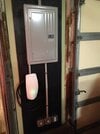Hmm, its not clear you understand the difference between the wall charger and the mobile charger? You used the term 'home charger' in your original post and it appears most of us assumed you meant wall charger, but maybe you actually meant mobile charger?
- The wall charger is permanently wired into your house and can handle up to a 60A breaker (48A continuous current): that is what all the discussions have been about here. With your 6/3 wire, your electrician would use a maximum 50A standard two-pole breaker to feed that circuit. With the wall charger, you can buy the less expensive standard (non-GFCI) breaker, but may need to add a disconnect switch, depending whether your electrical panel is visible from the receptacle and your locality's rules. That 50A breaker (40A continuous) would give you around 37 MPH charge rate on your Y on a 240V circuit.
- The mobile charger plugs in to a whole host of different receptacles via adapters you purchase from Tesla and will generate a maximum of 32A continuous. With your 6/3 wire, your electrician would install a 40A or 50A GFCI two-pole breaker to feed that circuit and also install a 14-50R or 6-50R receptacle. You would buy the 14-50P or 6-50P plug adapter (from Tesla) for your mobile charger, depending on which receptacle your electrician installed. Most electricians would use a 50A breaker in case that receptacle was used for a purpose other than your Tesla, together with a 14-50R receptacle in your case (6/3 wire vs. 6/2). An electrician with EV experience would most likely opt for a Hubbell, Cooper or Bryant brand 14-50R or 6-50R receptacle since they are 'industrial' rated to handle the high number of insertion/removal cycles possible with an EV charger (don't use Leviton: very poor quality, designed for ovens, not EV's). The mobile charger would give you a maximum 30 MPH charge rate on your Y.



